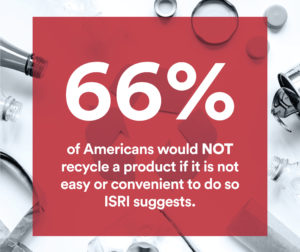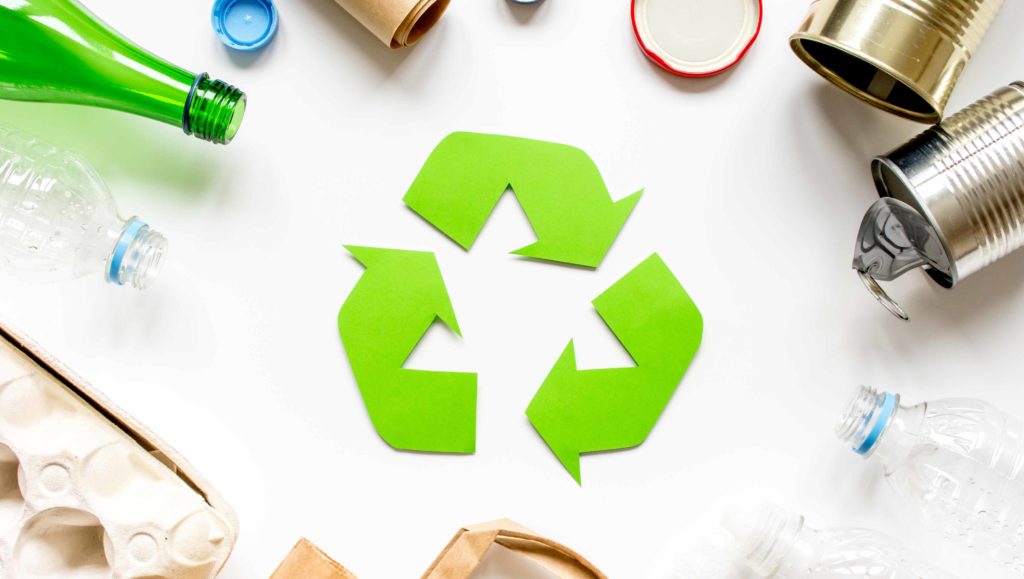Paper | Aluminum | Glass | E-Waste | Plastic | Textile | Food | C+D | Steel
In a world that simply has too much waste, recycling is an important practice to reduce landfill disposal. Landfills are notoriously bad, for both us and the environment, releasing carbon dioxide and other greenhouse gasses such as methane into the atmosphere. Today, for example, the municipal solid waste (MSW) recycling rate in the US remains as low as 35% and while numerous waste management initiatives aim to increase that number, there are plenty of challenges ahead for both consumers and the wider recycling industry.

One of the most evident challenges is found in the way we manage our waste streams. Today, each state, city, and metropolitan area takes a different approach to sustainability—meaning that what can be recycled in one town may be impossible to recycle in another. It’s no wonder that consumers at home don’t know what can be composted and what can’t, or whether those plastic bottles, paper towels, or old TVs have a place in our existing curbside recycling programs or municipal recycling bins.
One survey conducted by the Institute of Scrap Recycling Industries (ISRI) suggests that 66% of Americans would NOT recycle a product if it’s not easy or inconvenient to do so. It’s clear then, that removing the cloud of mystery surrounding our recycling practices while also increasing education and transparency is key to boosting recycling rates.
But how do we go about making recycling easier? How do we help recycled materials ease the burden on our dwindling natural resources? And what does the recycling landscape look like today? Here, we dive into a range of interesting recycling facts and statistics that will help both businesses and individuals get a better grasp of the recycling industry today.
Understanding recycling — What are the 3 Rs of recycling
Understanding the importance of recycling means we must acknowledge its place in our wider waste management practices. As part of the waste management hierarchy, recycling is the final piece of the three Rs system—Reduce, Reuse, Recycle. This means that, while recycling is highly important in the way we manage waste today, we should be looking towards the reduction and reuse of materials as the priority. Reducing the burden on the recycling industry is key to helping it work more effectively and efficiently.
 Paper recycling facts
Paper recycling facts
Paper, paper products, and card are widely recycled across the US and it’s among the most commonly recycled components of municipal solid waste (MSW), however, the huge amounts of unnecessary waste generated is still a cause for concern. These stats help put our paper and card waste into perspective:
- One study conducted in 2017 put the US spending on wrapping paper, tissue paper, and gift bags at $12.7 billion and most of it is not recycled.
- While many people dream of a paperless office, the average office worker generates around 2 pounds of paper and paperboard waste per day.
- Office paper waste is estimated to be around 12.1 trillion sheets of paper a year, with paper accounting for 50% of waste from businesses.
- When it comes to municipal waste, 67 million tons of paper and paperboard waste were generated in 2017 alone.
- Recycling one ton of paper products saves 3.3 cubic yards of landfill space.
- The average paper usage per person is around 700 pounds per year.
- Nearly 1 billion trees worth of paper is thrown away each year.
- It is difficult to know exactly how much paper is made from recycled materials, however, it is estimated that 40% of the world’s logging industry output goes into manufacturing virgin paper.
- It takes 14 bottles to create enough plastic fiberfill insulation for a ski jacket or 114 bottles to make enough plastic fiberfill insulation for a sleeping bag.
- Each ton of recycled paper saves an estimated 17 trees.
Aluminum recycling facts
Unlike many materials, aluminum can be recycled infinitely—at least in theory. However, while it is among the most easily recycled materials within our waste streams, and among the most profitable, tons of aluminum waste still ends up in landfill. Read these stats to understand our aluminum recycling habits.
- The degrade time for aluminum is around 200-500 years, meaning that if it does go to landfill it takes a very long time to break down.
- The total aluminum waste production in 2017 was 383 million tons.
- It is estimated that around 75% of all the aluminum ever produced is still in use today.
- The amount of aluminum that is recycled each year amounts to about 620,000 tons.
- A massive 80 billion soda cans are consumed in the US each year.
- The recycling rate of aluminum cans is around 63.6 percent.
- Recycling a single aluminum can could power a television for 3 hours.
- 105,800 aluminum cans are recycled every minute in the US.
- Americans throw away enough aluminum to rebuild the US commercial air fleet every 3 months.
Glass recycling facts
Glass takes a very long time to break down in landfill and the market for recycled glass is poor due to contamination, breakage, and separation by color. However, it is extremely easy to reuse and repurpose for a huge range of different applications. Here we look at the state of glass recycling today.
- The average time for a glass bottle to decompose is around 4,000 years.
- 28 billion glass bottles and jars go to landfill each year.
- Glass is endlessly recyclable and generally doesn’t suffer from loss of quality or purity.
- Around 10 million tons of glass that is disposed of by Americans gets recycled each year.
- The glass recycling rate in the US is around 33%.
- Light bulbs pose numerous issues, and while some can be recycled, others can only be sent to landfill.
- 1.5 million tons of glass is incinerated each year in energy recovery facilities.
E-waste recycling facts
As one of the fastest-growing waste streams in the world, e-waste is both difficult to recycle and full of toxic materials. Ensuring these types of products remain in circulation for as long as possible is critical to reducing the burden on the recycling industry and ensuring electronics don’t go to landfill. This is what the e-waste recycling landscape looks like today.
- In the US, it is estimated that the average person generates around 20 kg of e-waste annually.
- In 2017, around 2.8 million tons of selected consumer electronic waste was generated, including televisions, VCRs, DVD players, video cameras, stereo systems, phones, and computer equipment.
- 1 million tons of selected consumer electronics were recycled in 2017.
- Some estimates suggest that 40% of the heavy metals found in landfills come from electronic products.
- Discarded electronics in landfills make up 2% of the total trash found there.
- 14 million tons of e-waste are generated each year in New York City alone.
Plastic recycling facts
Single-use plastic remains a huge issue despite increasing awareness as to the damage it causes. Today, both consumers and producers are looking at ways to move away from our reliance on these materials, however, the statistics surrounding plastic disposal and recycling paint a worrying picture.
- Around 5 million plastic bottles are thrown away in the US every hour, putting the figure at around 35 billion plastic bottles annually.
- While plastic bag bans are now coming into effect, it is estimated that there are 100 million plastic bags used in the US each year.
- Plastic bags and water bottles may take up to 1,000 years to decompose in landfill and lead to microplastics entering the ocean.
- Plastic in the ocean is a huge problem with estimates suggesting that 8 million metric tons of plastic end up in the world’s oceans annually.
- One study suggests that plastic pollution affects at least 700 marine species, but in reality, this figure is likely to be much higher.
- The plastic bottle recycling rate for PET bottles in the US is around 30%.
- The average office worker uses around 500 disposable cups per year in the US, with many of these products containing plastics.
- Multi-material plastic packaging is among the most difficult types of waste to recycle.
- It takes around 0.4 gallons of oil to manufacture a pound of virgin plastic.
Textile recycling facts
The fashion industry is considered among the most environmentally destructive on the planet, and textile waste is a big part of the problem. Fast fashion plays a large role in the waste generated, and much of the textile waste we dispose of is recyclable. Reusing or donating old clothing can also help reduce the number of textiles going to landfill. Here, we look at the facts and figures surrounding textile waste.
- It is estimated that around 16.9 million tons of textile waste is generated each year in the United States.
- Americans dispose of 13 million tons of textiles (about 85 percent of their clothes) each year.
- Some clothing can take up to 40 years to decompose in landfill.
- The average lifetime of a piece of clothing is as little as three years.
- Recycling rates for all textiles is around 15%.
- The USA is a world leader in exporting used textiles, accounting for more than 40% annually.
- 95% of textiles have the potential to be recycled or reused.
 Food waste recycling facts
Food waste recycling facts
Food waste is a growing issue around the world, and while waste occurs at every stage of the process (from production to consumption), consumers generate the most waste by far. Composting is one way to deal with food waste, however, better management and organization can also help reduce food waste before recycling to expend less energy in production, distribution, and subsequently, recycling.
- 80 billion pounds of food is thrown away in the US each year.
- About 94% of the food we throw away ends up in landfills where it rots and releases methane and CO2.
- Composting is an effective way to deal with true food waste, turning organics into healthy soils.
- Food waste is responsible for around 8% of global greenhouse emissions.
- More than $161 billion is lost each year to food waste.
- There are around 4,914 industrial composting facilities in the US.
Construction and demolition (C&D) waste
C&D waste is notoriously difficult to recycle. This is due to both the types of materials used and the way the waste is generated, as demolition generally mixes all kinds of materials with little hope of separation. However, many materials associated with C&D can be reduced, reused, and recycled, and finding new ways to do this is important.
- 569 million tons of C&D were generated in 2017.
- 90% of C&D waste is generated from demolition.
- Concrete is among the most destructive materials we currently produce.
- Concrete and asphalt make up around 75% of the C&D waste stream.
- Buildings themselves account for around 39% of CO2 emissions in the US.
Solid waste and landfill facts
Municipal solid waste (MSW) is everything we throw away in our trashcans, and a shocking amount ends up in landfill or is sent to incinerators. By ensuring we recycle conscientiously, as well as educating ourselves on how to improve recycling rates we can significantly reduce waste. Here we look at the facts and figures on our landfill practices.
- There are currently more than 2,600 MSW landfill sites in the US.
- On average, Americans throw away about 1,200 pounds of organic garbage each year.
- We only recycle about 67.2 million tons of a possible 267.8 million tons – less than a quarter of total MSW.
- The EPA estimates that around 75% of all waste is recyclable.
- Each American produces about 4.51 pounds of trash in a single day.
- Daily garbage generation is about 728,000 tons.
- During the winter holiday season, about 25% more trash is generated. That’s around 25 million tons.
- Around one third of landfill space is taken up with packaging materials.
- Michigan and Indiana have the most trash in landfills, while Tennessee and Texas have the least.
Steel recycling facts
Steel products, such as steel cans and other consumer items, can also be recycled infinitely without a loss of strength or integrity. However, manufacturing virgin steel takes a lot of energy and uses raw materials that must be mined, as well as releasing greenhouse gases during production. In addition to this, manufacturing one ton of steel is estimated to take 34000 gallons of water. Keeping it out of landfill is a must, however, reusing is also preferable to recycling. Having said this, recycling can and does save plenty of energy, as well as ensuring precious raw materials are used again in new products. Read these facts and learn about steel recycling today.
- Using recycled steel saves enough energy to power 18 million homes for a year.
- According to the Environmental Protection Agency, around 10.5 million tons of steel is landfilled each year.
- Steel cans are the most recycled packaging product in the world.
- Steel is a ferrous metal, which means it is magnetic. This means it is easily separated by magnets during the recycling process.
- Steel cans weigh 33% less today than they did 25 years ago.
- Steel cans help keep food fresher for longer—meaning less food waste.
For more information on how both individuals and businesses can improve recycling rates and optimize waste management, subscribe to the RTS blog today. Additionally, for tailored insights into your waste management practices, contact one of our LEED-accredited advisors.










